Since Sir Alex Ferguson left the club, Manchester United have had no less than 10 managers, including interim appointments, with Rúben Amorim now becoming the latest to take on the role.
Despite a series of managerial changes, United have struggled to find a coach who can restore them to their former glory — reaching UEFA Champions League finals and dominating the Premier League.
Now, it’s up to Amorim to bring stability and take on the increasingly daunting task of leading United back to their glory days.
In this tactical analysis, we provide an in-depth analysis of Amorim’s coaching philosophy
and tacticsand how we expect him to set up at Manchester United.
Rúben Amorim Tactics & Philosophy
Rúben Amorim’s style of play revolves around a 3-4-3 formation, which he plans to bring to Manchester United.
This setup, rarely seen in English football or United’s history, is designed to control possession with a disciplined build-up strategy.
Amorim emphasises vertical play and prefers versatile players who can adapt to multiple roles in different scenarios.
Under his approach, one-dimensional players may struggle to secure their positions.
Amorim has a reputation for developing young talent, as seen at Sporting CP, where some of his most important players are the wing-backs.
These players are given the freedom to push high up the pitch, covering large areas and integrating into central positions or making wide runs.
His style relies heavily on vertical passing and breaking lines, requiring centre-backs capable of precise forward passes and quick-holding midfielders who can make decisions on the fly.
How Will He Fit In At Manchester United?
Amorim has a great selection of players to work with at Manchester United.
While the squad has talent, it’s currently an unbalanced, individualistic group lacking structure and direction.
Amorim’s primary task will be to fully utilise the talent within the existing squad by:
- Maximising player roles and potential
- Focusing on individual player development
- Establishing a clear vision and style of play within the team
Amorim brings all three of these qualities, making him one of the best managerial choices for United.
The club should avoid bringing in any new transfers this January.
Instead, let Amorim play around with the current squad.
By the end of the season, United will have a clearer picture of the areas that genuinely need strengthening.
Only then should new transfers be considered.
Rúben Amorim Out Of Possession Tactics
Out of possession, Amorim’s teams are adept at shifting into two tactical setups: either a classic 4-4-2 or a 5-4-1 formation.
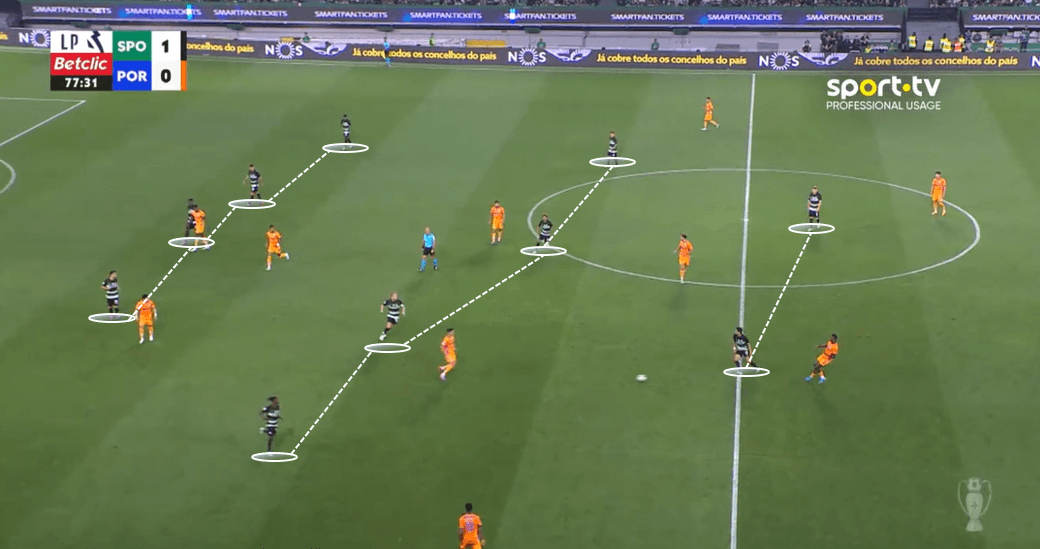
In the 4-4-2 setup, as shown in the first image, his team maintains a compact shape with an extremely narrow backline.
Unlike typical setups where full-backs provide width, Amorim prefers them to stay closer to the centre, providing extra cover.
This allows the wide players to have more defensive duties, tracking back to cover the flanks when needed.
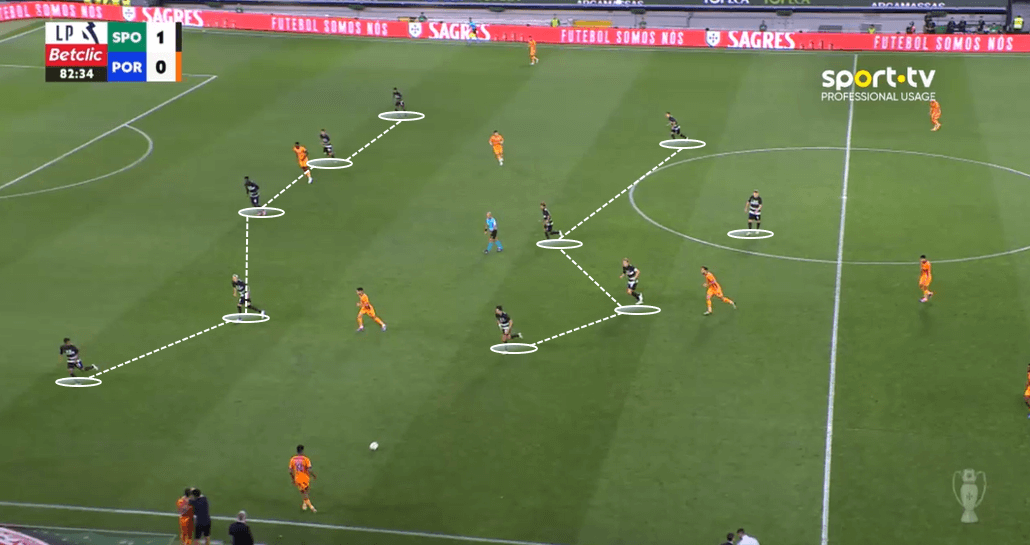
In the second image, the 5-4-1 formation, commonly used at Sporting, is displayed — a setup we can expect him to implement at Manchester United as well.
The 4-4-2 formation is familiar within United’s history, which may help players feel more comfortable adopting it.
However, the 5-4-1, with high-energy full-backs pressing aggressively in specific situations, may require some adjustment.
United has struggled with defensive positioning in recent years, so the team will need to be highly organised to execute this manoeuvre effectively.
How Will This Be Implemented At Manchester United?
Amorim’s use of the 4-4-2 setup could be highly effective for Manchester United.
This formation allows players like Noussair Mazraoui, Luke Shaw, or Diogo Dalot to settle into their natural roles within a 4-4-2 mid-block, providing stability in defence.
Meanwhile, the high-energy, long-legged Joshua Zirkzee can partner Rasmus Hojlund up front, forming a dynamic striker partnership in the press.
This setup also enables Alejandro Garnacho, Marcus Rashford, Bruno Fernandes, Mason Mount, Manuel Ugarte, and Casemiro to occupy the second defensive line, maintaining roles similar to what they’re used to.
Some adjustments will be required to optimise each player’s positioning, but overall, this formation allows United to balance defensive solidity with aggressive pressing up top.
Rúben Amorim In Possession Tactics
In possession, Amorim’s teams adopt a very intriguing approach.
During the build-up phase, they initially shape into a 4-2-4 when the ball is with the goalkeeper.
However, as they progress higher up the pitch, the formation shifts, transitioning into a 3-4-3 setup.
This flexible structure allows Amorim’s teams to maintain a solid defensive foundation while adding numbers in advanced areas, creating opportunities for dynamic attacking plays.
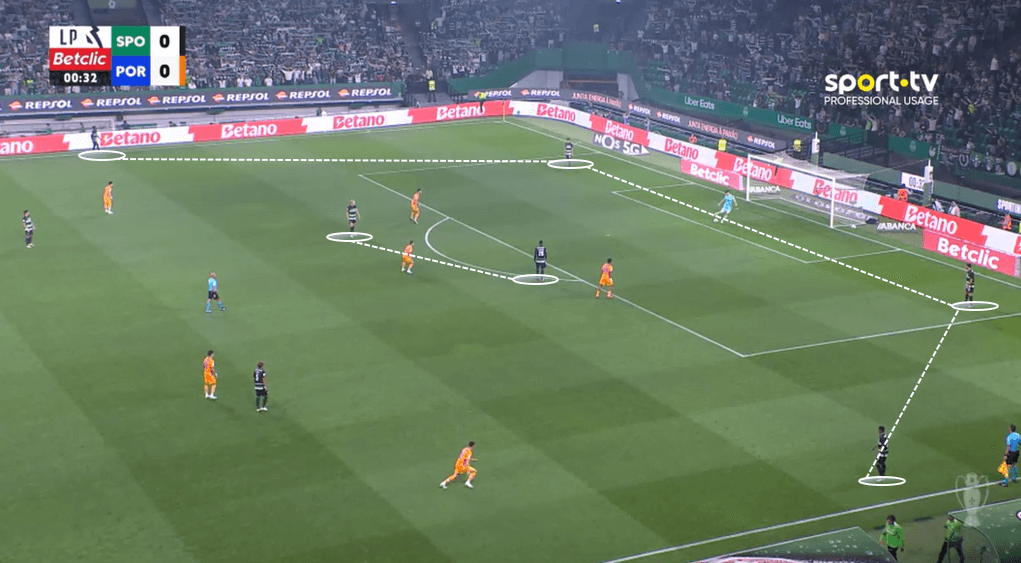
In the first image, we see Amorim’s 4-2-4 build-up, a setup reminiscent of Erik ten Hag’s approach during his time at Manchester United.
Interestingly, Ugarte is now reunited with Amorim, a manager who trusted him deeply at Sporting.
We can expect Ugarte to take a central role in the double pivot, though his midfield partner remains an open question.
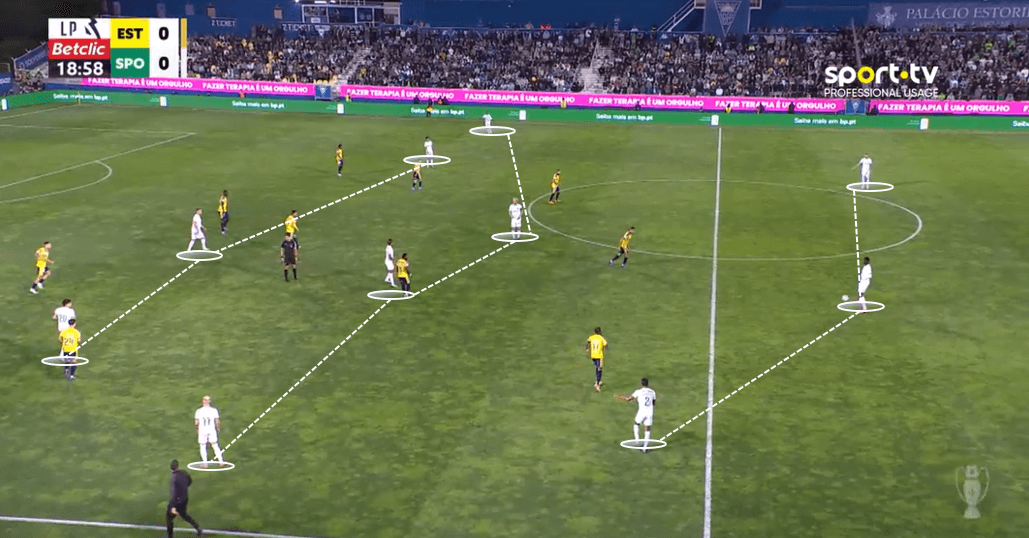
In the second image, the team transitions to a 3-4-3 with a three-man backline, which could be challenging for United as they determine the best fit for this setup.
It’s likely there will be considerable speculation and discussion about which players suit this formation.
Adjustments will be necessary, and fans should expect some trial and error as the team adapts.
How Will This Be Implemented At Manchester United?
The 3-4-3, with an extremely high line from the full-backs, could present United with some tactical advantages.
Both Lisandro Martínez and Leny Yoro are great at reading passing lanes with vertical passes — a quality Amorim values — and they could slot very well into his system.
Matthijs De Ligt, while less proficient with the ball, offers the physical presence and defensive reliability that balances out the backline.
Essentially, this creates a strong three-man backline with two ball-playing defenders and one robust central presence.
Maguire, too, might find his footing in this system, potentially revitalizing his career in a setup similar to the one England has used.
For the full-back positions, Dalot, Mazraoui, and Shaw would likely thrive with the open space ahead, allowing them the freedom to advance and stretch play.
Ugarte would anchor the double pivot in midfield, but who will partner him in that central role remains to be seen.
Rúben Amorim Attacking Tactics
Arguably, the hardest part of Amorim’s work at Manchester United will be optimising the attacking setup.
As we documented in an article a few weeks ago, United has consistently reached the penalty box and created scoring opportunities, but poor finishing has cost them crucial points by failing to capitalise on these chances.
One concept Amorim has introduced to improve attacking efficiency is game awareness combined with a tactic known as ‘double movement’ — where attackers make an initial move before darting in behind the defence.

In the first image, the ball is played vertically to the winger.
As this pass is made, a second player, marked in white, begins making his run forward in sync with the first.
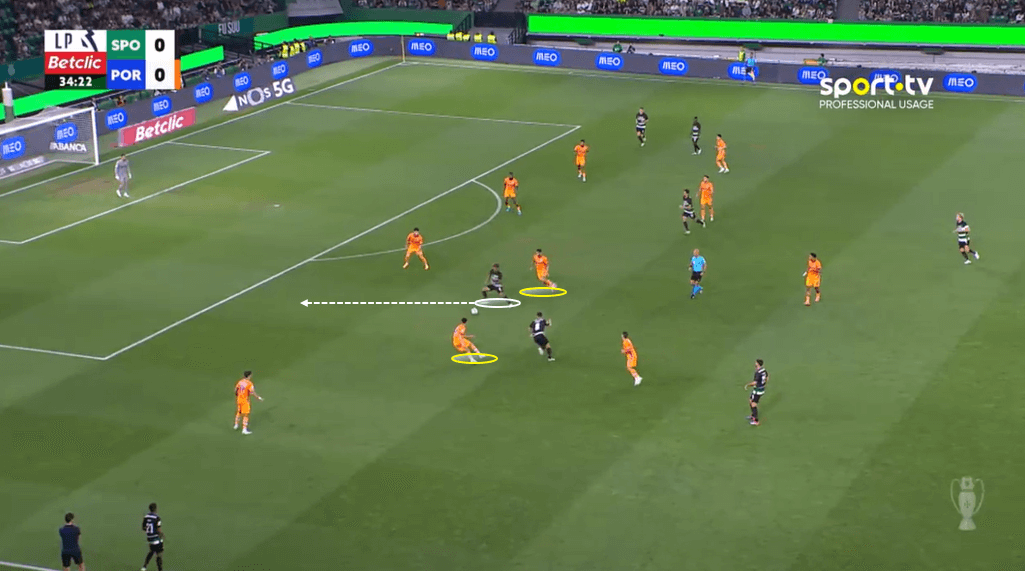
In the second image, we see the outcome of this sequence.
Two Porto players gravitate toward the winger in possession, leaving space for the second player to exploit with his run.
This double-movement strategy is vital to Amorim’s attacking tactics, designed to disorganise defences and create high-quality chances.
How Will This Be Implemented At Manchester United?
Manchester United has a roster full of smart attacking players with strong technical abilities.
Joshua Zirkzee, a natural second striker, along with Garnacho, Mount, and Fernandes, are key players in this attacking tactic.
Their intelligence and speed are essential in Amorim’s strategy, especially as players like Hojlund and Rashford make timed runs into the box when space opens up.
While United has managed to reach the penalty area frequently, the main issue has been missing scoring opportunities rather than creating them — a challenge more related to player finishing quality than coaching tactics.
However, with a coach like Amorim driving the team forward and creating more chances, the likelihood of converting those opportunities into goals increases.
Sporting CP vs Manchester United Statistics
Sporting CP Penetration Carries Map
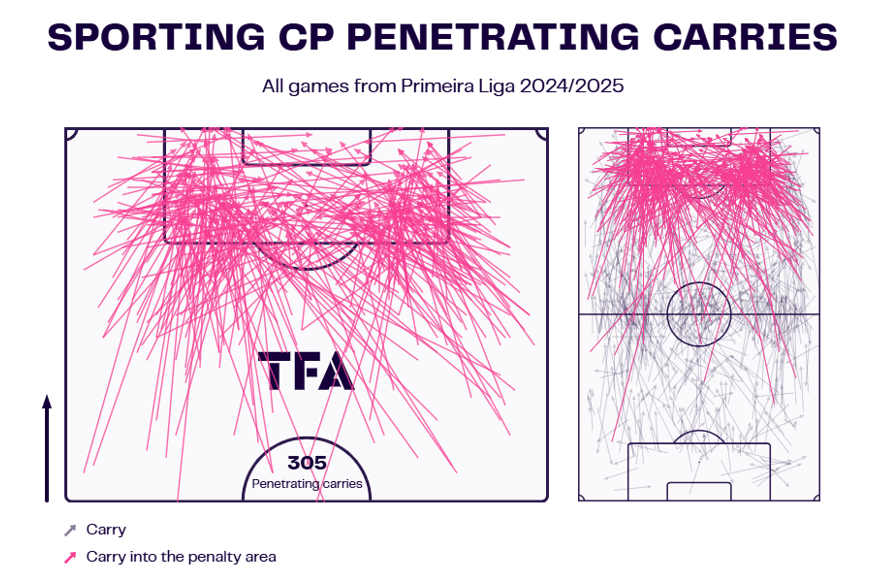
Manchester United Penetration Carries Map
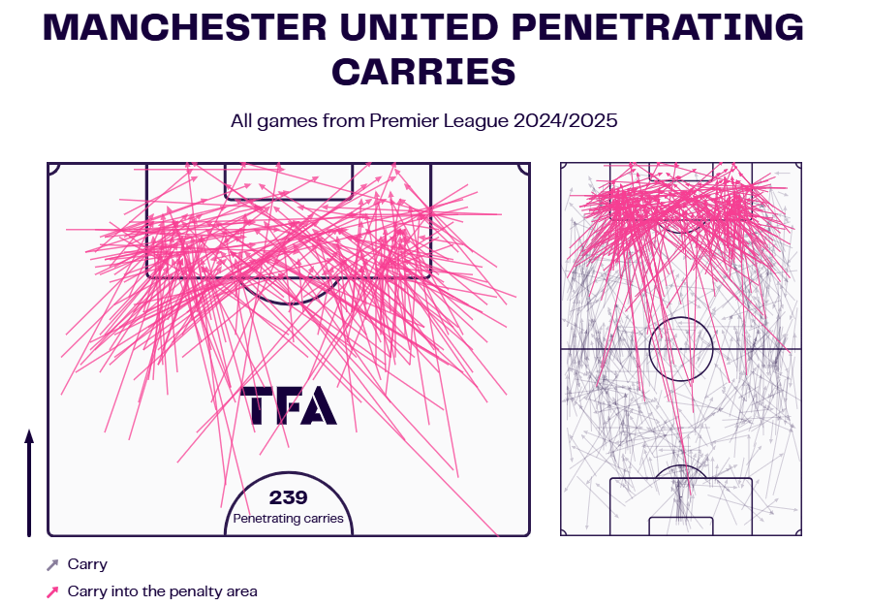
When comparing the penetration carries map of both clubs, Sporting CP have performed significantly better than Manchester United so far this season, despite having a lower-quality pool of players.
With Amorim’s attacking tactics transferring over to United, there’s potential for success.
The English league is more challenging, but with Amorim now working with higher-quality players, these tactics could definitely benefit the club.
Sporting CP Regain Map
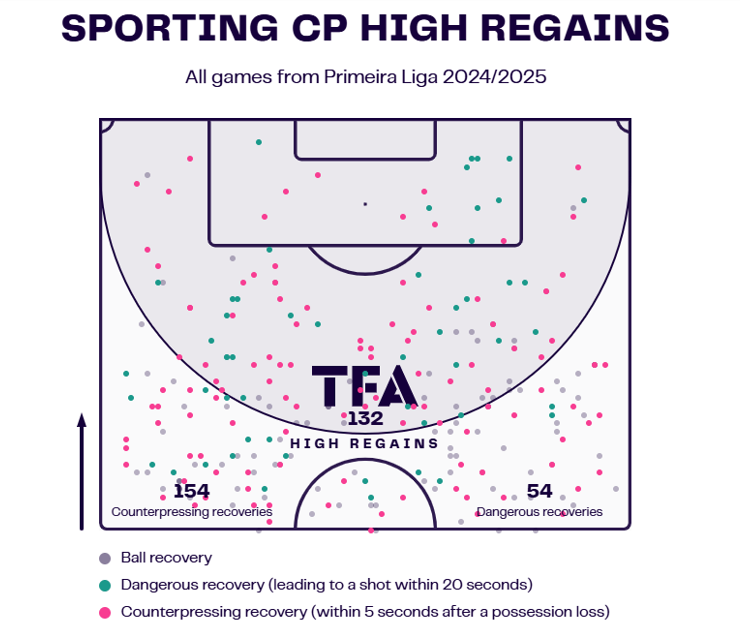
Manchester United Regain Map
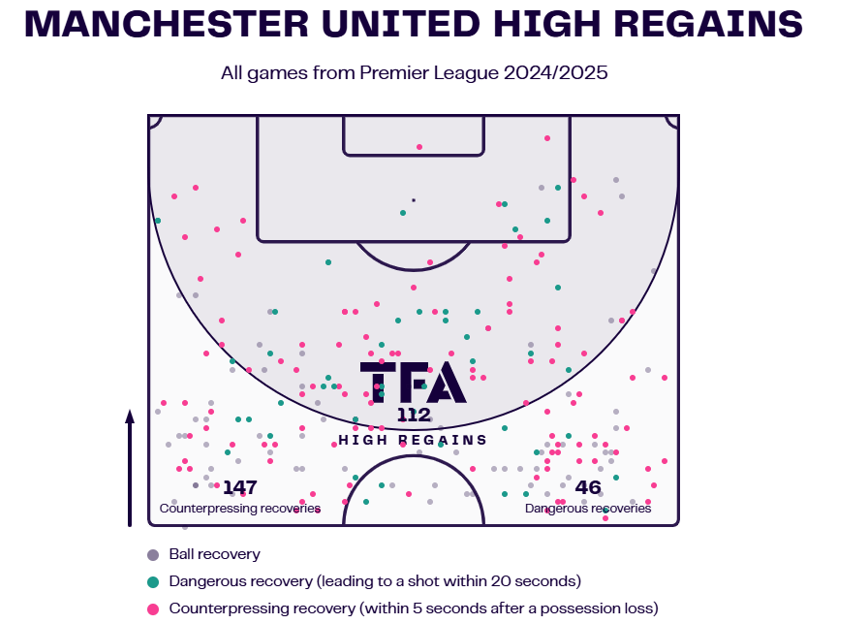
Sporting’s counterpressing regain map outperforms United’s due to the greater structure and discipline that Amorim instils in his teams.
Under Erik ten Hag, United aimed to become a counterpressing powerhouse similar to the styles of Jürgen Klopp or Thomas Tuchel, but it never fully materialised.
Now, with Amorim at the helm, he can bring his pressing tactics from Sporting to United, potentially making that vision a reality.
Sporting CP Ball Progression Map
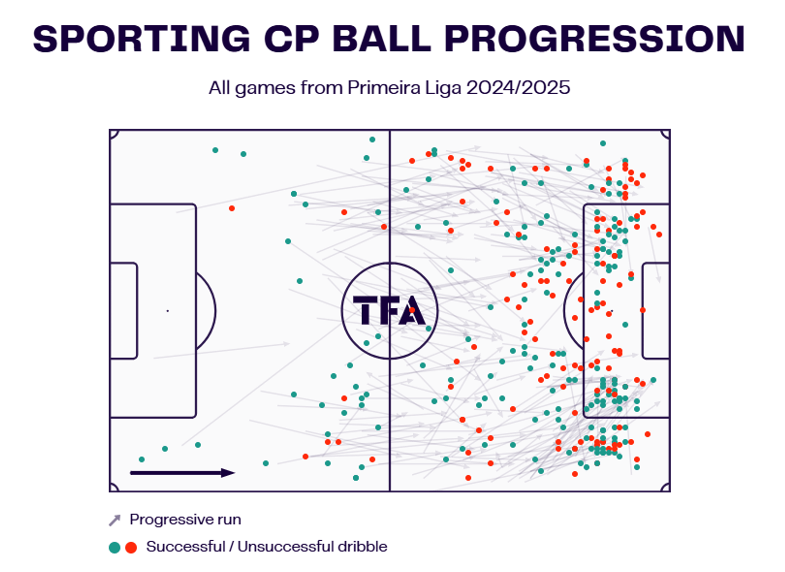
Manchester United Progression Map
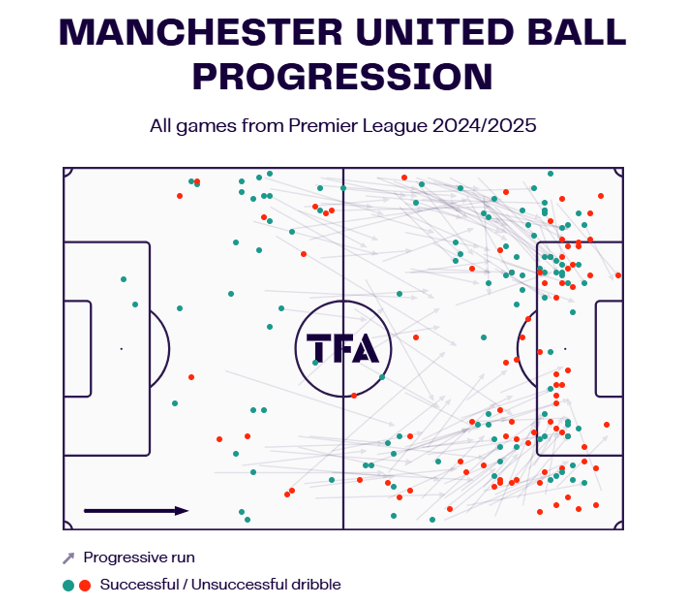
Sporting’s ball progression map is significantly more advanced and dynamic than United’s; it’s almost like comparing a relegation-level team’s ball progression to that of last season’s Champions League winners.
Sporting shows much higher density and fluidity in moving the ball forward, especially in transitions from midfield to the final third.
This contrast is evident on the progression map.
One of United fans’ common complaints has been the team’s lack of fluidity.
It often seems as though players are improvising rather than following a clear structure.
The difference in Sporting’s ball progression map highlights how much more effectively they penetrate forward, showing a structured, cohesive approach that United has been missing.
Conclusion
Rúben Amorim’s appointment marks a bold new chapter for Manchester United.
With a structured 3-4-3 formation, a disciplined build-up style, and an emphasis on versatile, game-aware players, Amorim has the potential to bring much-needed stability and tactical clarity to Old Trafford.
His philosophy has transformed Sporting CP, and with United’s stronger player pool, these tactics could be even more impactful in the English league.
Key to his success will be his ability to implement a cohesive structure both in possession and out of possession.
Amorim’s setups — the adaptable 4-4-2 and 5-4-1 formations out of possession and the 4-2-4 to 3-4-3 transition in possession — are designed to control games, maximise space, and create a more fluid attacking approach.
This tactical identity will require some adjustment, but with an existing squad of technically gifted players, Amorim’s tactics could finally give United the disciplined edge they’ve sought for years.
If United trusts Amorim’s approach and avoids hasty transfers, allowing him time to adapt the squad, they could see a major transformation by 2026.
By committing to Amorim’s vision, United can once again build a team capable of challenging for top honours, rekindling the glory of past eras and setting a clear direction for the future.

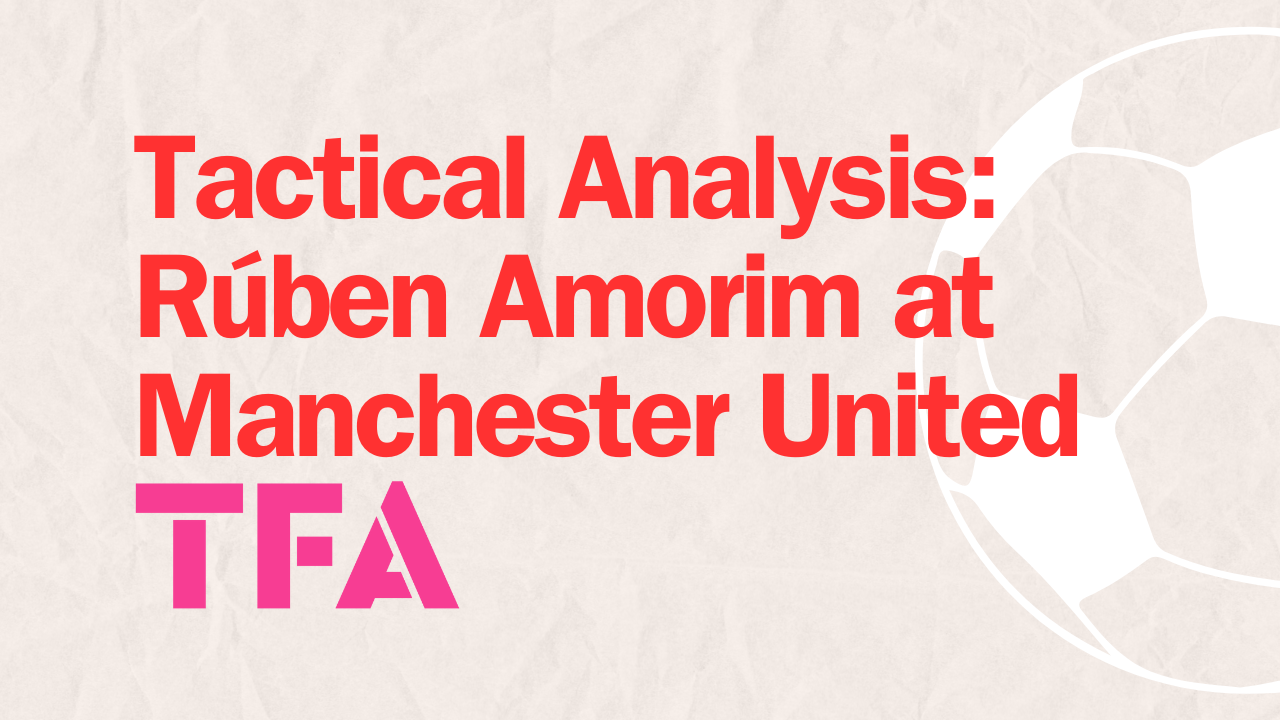



Comments